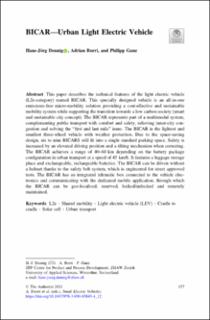Bitte benutzen Sie diese Kennung, um auf die Ressource zu verweisen:
https://doi.org/10.21256/zhaw-22327| Publikationstyp: | Buchbeitrag |
| Art der Begutachtung: | Peer review (Publikation) |
| Titel: | BICAR : urban light electric vehicle |
| Autor/-in: | Dennig, Hans-Jörg Burri, Adrian Ganz, Philipp |
| et. al: | No |
| DOI: | 10.1007/978-3-030-65843-4_12 10.21256/zhaw-22327 |
| Erschienen in: | Small Electric Vehicles |
| Seite(n): | 157 |
| Seiten bis: | 166 |
| Erscheinungsdatum: | 22-Apr-2021 |
| Verlag / Hrsg. Institution: | Springer |
| Verlag / Hrsg. Institution: | Cham |
| ISBN: | 978-3-030-65842-7 978-3-030-65843-4 |
| Sprache: | Englisch |
| Schlagwörter: | Mobilität; Shared mobility; L2e; Light electric vehicle (LEV); Cradle to cradle; Solar cell; Urban transport |
| Fachgebiet (DDC): | 629: Luftfahrt- und Fahrzeugtechnik |
| Zusammenfassung: | This paper describes the technical features of the light electric vehicle (L2e-category) named BICAR. This specially designed vehicle is an all-in-one emissions-free micro-mobility solution providing a cost-effective and sustainable mobility system while supporting the transition towards a low carbon society (smart and sustainable city concept). The BICAR represents part of a multimodal system, complementing public transport with comfort and safety, relieving inner-city congestion and solving the “first and last mile” issue. The BICAR is the lightest and smallest three-wheel vehicle with weather protection. Due to the space-saving design, six to nine BICARS will fit into a single standard parking space. Safety is increased by an elevated driving position and a tilting mechanism when cornering. The BICAR achieves a range of 40–60 km depending on the battery package configuration in urban transport at a speed of 45 km/h. It features a luggage storage place and exchangeable, rechargeable batteries. The BICAR can be driven without a helmet thanks to the safety belt system, which is engineered for street approved tests. The BICAR has an integrated telematic box connected to the vehicle electronics and communicating with the dedicated mobile application, through which the BICAR can be geo-localised, reserved, locked/unlocked and remotely maintained. |
| URI: | https://digitalcollection.zhaw.ch/handle/11475/22327 |
| Volltext Version: | Publizierte Version |
| Lizenz (gemäss Verlagsvertrag): | CC BY 4.0: Namensnennung 4.0 International |
| Departement: | School of Engineering |
| Organisationseinheit: | Institute of Product Development and Production Technologies (IPP) |
| Enthalten in den Sammlungen: | Publikationen School of Engineering |
Dateien zu dieser Ressource:
| Datei | Beschreibung | Größe | Format | |
|---|---|---|---|---|
| 2021_Dennig-Burri-Ganz_BICAR-Urban-Light-Electric-Vehicle.pdf | 677.67 kB | Adobe PDF |  Öffnen/Anzeigen |
Zur Langanzeige
Dennig, H.-J., Burri, A., & Ganz, P. (2021). BICAR : urban light electric vehicle. In Small Electric Vehicles (pp. 157–166). Springer. https://doi.org/10.1007/978-3-030-65843-4_12
Dennig, H.-J., Burri, A. and Ganz, P. (2021) ‘BICAR : urban light electric vehicle’, in Small Electric Vehicles. Cham: Springer, pp. 157–166. Available at: https://doi.org/10.1007/978-3-030-65843-4_12.
H.-J. Dennig, A. Burri, and P. Ganz, “BICAR : urban light electric vehicle,” in Small Electric Vehicles, Cham: Springer, 2021, pp. 157–166. doi: 10.1007/978-3-030-65843-4_12.
DENNIG, Hans-Jörg, Adrian BURRI und Philipp GANZ, 2021. BICAR : urban light electric vehicle. In: Small Electric Vehicles. Cham: Springer. S. 157–166. ISBN 978-3-030-65842-7
Dennig, Hans-Jörg, Adrian Burri, and Philipp Ganz. 2021. “BICAR : Urban Light Electric Vehicle.” In Small Electric Vehicles, 157–66. Cham: Springer. https://doi.org/10.1007/978-3-030-65843-4_12.
Dennig, Hans-Jörg, et al. “BICAR : Urban Light Electric Vehicle.” Small Electric Vehicles, Springer, 2021, pp. 157–66, https://doi.org/10.1007/978-3-030-65843-4_12.
Alle Ressourcen in diesem Repository sind urheberrechtlich geschützt, soweit nicht anderweitig angezeigt.